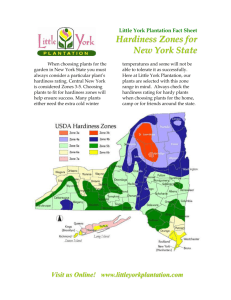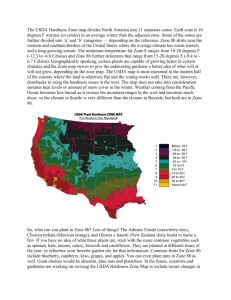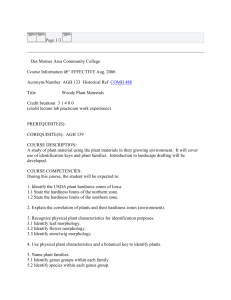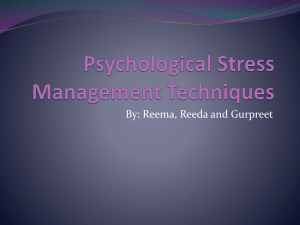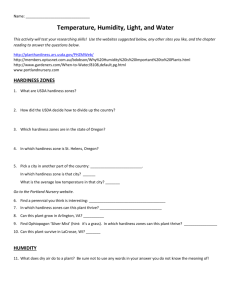Current Research Journal of Biological Sciences 6(3): 122-127, 2014
advertisement
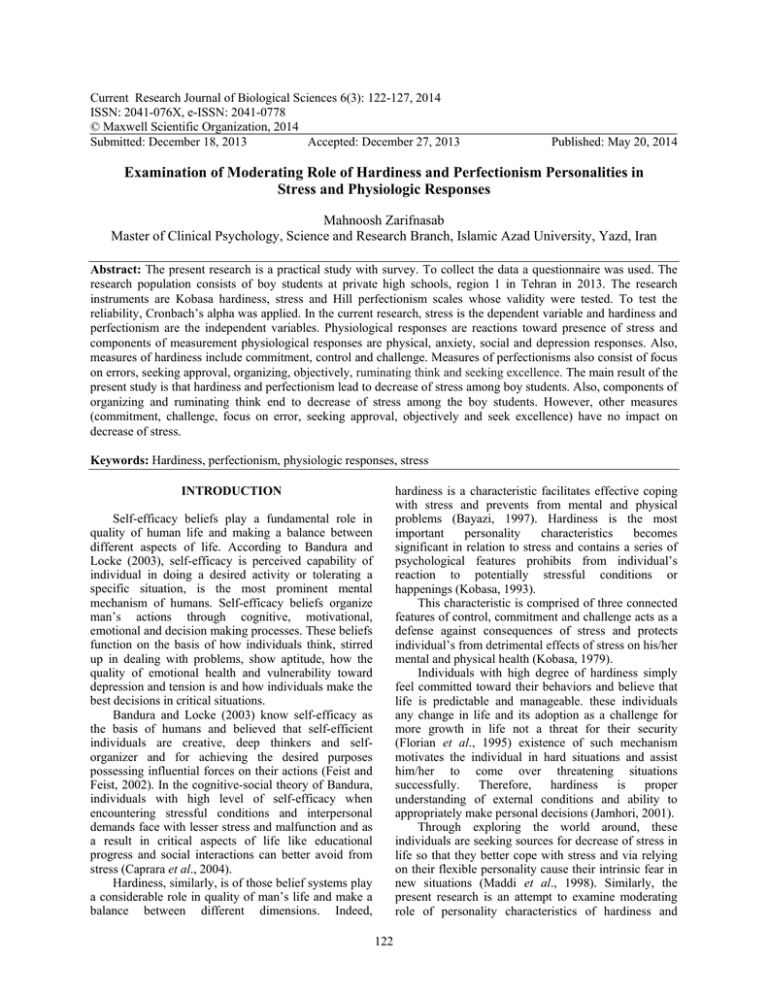
Current Research Journal of Biological Sciences 6(3): 122-127, 2014 ISSN: 2041-076X, e-ISSN: 2041-0778 © Maxwell Scientific Organization, 2014 Submitted: December 18, 2013 Accepted: December 27, 2013 Published: May 20, 2014 Examination of Moderating Role of Hardiness and Perfectionism Personalities in Stress and Physiologic Responses Mahnoosh Zarifnasab Master of Clinical Psychology, Science and Research Branch, Islamic Azad University, Yazd, Iran Abstract: The present research is a practical study with survey. To collect the data a questionnaire was used. The research population consists of boy students at private high schools, region 1 in Tehran in 2013. The research instruments are Kobasa hardiness, stress and Hill perfectionism scales whose validity were tested. To test the reliability, Cronbach’s alpha was applied. In the current research, stress is the dependent variable and hardiness and perfectionism are the independent variables. Physiological responses are reactions toward presence of stress and components of measurement physiological responses are physical, anxiety, social and depression responses. Also, measures of hardiness include commitment, control and challenge. Measures of perfectionisms also consist of focus on errors, seeking approval, organizing, objectively, ruminating think and seeking excellence. The main result of the present study is that hardiness and perfectionism lead to decrease of stress among boy students. Also, components of organizing and ruminating think end to decrease of stress among the boy students. However, other measures (commitment, challenge, focus on error, seeking approval, objectively and seek excellence) have no impact on decrease of stress. Keywords: Hardiness, perfectionism, physiologic responses, stress hardiness is a characteristic facilitates effective coping with stress and prevents from mental and physical problems (Bayazi, 1997). Hardiness is the most important personality characteristics becomes significant in relation to stress and contains a series of psychological features prohibits from individual’s reaction to potentially stressful conditions or happenings (Kobasa, 1993). This characteristic is comprised of three connected features of control, commitment and challenge acts as a defense against consequences of stress and protects individual’s from detrimental effects of stress on his/her mental and physical health (Kobasa, 1979). Individuals with high degree of hardiness simply feel committed toward their behaviors and believe that life is predictable and manageable. these individuals any change in life and its adoption as a challenge for more growth in life not a threat for their security (Florian et al., 1995) existence of such mechanism motivates the individual in hard situations and assist him/her to come over threatening situations successfully. Therefore, hardiness is proper understanding of external conditions and ability to appropriately make personal decisions (Jamhori, 2001). Through exploring the world around, these individuals are seeking sources for decrease of stress in life so that they better cope with stress and via relying on their flexible personality cause their intrinsic fear in new situations (Maddi et al., 1998). Similarly, the present research is an attempt to examine moderating role of personality characteristics of hardiness and INTRODUCTION Self-efficacy beliefs play a fundamental role in quality of human life and making a balance between different aspects of life. According to Bandura and Locke (2003), self-efficacy is perceived capability of individual in doing a desired activity or tolerating a specific situation, is the most prominent mental mechanism of humans. Self-efficacy beliefs organize man’s actions through cognitive, motivational, emotional and decision making processes. These beliefs function on the basis of how individuals think, stirred up in dealing with problems, show aptitude, how the quality of emotional health and vulnerability toward depression and tension is and how individuals make the best decisions in critical situations. Bandura and Locke (2003) know self-efficacy as the basis of humans and believed that self-efficient individuals are creative, deep thinkers and selforganizer and for achieving the desired purposes possessing influential forces on their actions (Feist and Feist, 2002). In the cognitive-social theory of Bandura, individuals with high level of self-efficacy when encountering stressful conditions and interpersonal demands face with lesser stress and malfunction and as a result in critical aspects of life like educational progress and social interactions can better avoid from stress (Caprara et al., 2004). Hardiness, similarly, is of those belief systems play a considerable role in quality of man’s life and make a balance between different dimensions. Indeed, 122 Curr. Res. J. Biol. Sci., 6(3): 122-127, 2014 perfectionism in relation to stress and physiologic responses in an actual community. Clearly, all obtained results will be applicable. balance will be stressful. When the body exposes to stress it reacts in a way that balance the body, which is stress itself (Koolhaas et al., 2011). THEORETICAL FRAMEWORK Physiologic responses: Physiologic responses are response to stimuli (like stress) through physiological symptoms of depression, schizophrenia, emotion, memory, learning, sexual behavior or speech as well as disorders like insomnia, overeating, not writing, not reading, apraxia and agnosia both in biological and neurological levels (Marc Breedlove et al., 2007). Doubtless, the main cause of most of physical diseases and mental disorders is rate of tolerating mental stress and the individual’s inability to cope with it. Although, most of today jobs are a source of stress, employees know well how to encounter with stressful work conditions. They also know deal with stressful stimuli and avoid from their damaging effects. But some employees fail to encounter or evade from stressful stimuli. Such individuals suffer from burnout and consequently their difficulty in face of stress becomes evident in different cognitive, emotional and behavioral fields. In fact, self-awareness allows us to judge our behavior for achieving our purposes and ideals. According to this theory, in self-organizing, the individual evaluate his /her own behavior and if it accords his/her standards, his/her behavior is judged well and motivates him/her. If the behavior is not standard, he/she tries to change the behavior and achieve those standards and then reevaluates himself/herself to see whether or not he/she could get closer to the standards or becomes perfectly standard. When there is no gap between a behavior and standards, then this process is hindered or the individual forgets it totally. The next section will present some definition of the independent and dependent variables. 5T 5T Research background: The purpose of McNellis (2013) study is to expand upon accounting literature that highlights the benefits of hardiness in the accounting environment. Accordingly, the relationship between hardiness and accounting task performance is investigated across two scenarios in the presence of conscientiousness, a well-documented predictor of performance (Barrick and Mount). Design/methodology/approach-Subjects completed a bank reconciliation task with either an immediate deadline or a non-immediate deadline. The personality traits were measured with scales from prior literature. Findings-the relationship between the commitment dimension of hardiness and task performance was positive and significant in the presence of the immediate deadline, but not the non-immediate deadline. Conversely, the conscientiousness-task performance relationship was positive and significant under the non-immediate deadline, but not the immediate deadline (McNellis, 2013). Tho Nguyen in his study gathered survey data from a convenience sample of 1,024 business students in Vietnam and then validated measures of four constructs: Quality of College Life, psychological hardiness in learning, learning motivation and perceived functional value of business education. The relationships among the constructs were estimated by Structural Equation Modeling. The results demonstrate that psychological hardiness in learning and learning motivation have statistically significant positive impacts on students’ perceived Quality of College Life. The impacts are significantly stronger for students with higher assessments of the functional value of a business education (Nguyen et al., 2012). Väänänen, Ari in his paper examines the process of formulating and defining the concept of work stress in the occupational health sciences and in industrial and organizational psychology from the early 1960s to the late 1990s. The empirical material of the study encompasses 108 scientific articles, books, book chapters, ‘state of the art’ reviews, book reviews and written conference presentations. The data are analyzed in the frameworks of historical sociology, critical psychology and the anthropology of knowledge. Researchers with a psychological orientation emphasized micro-level Hardiness: Peoples who suffer high degree of tension with no disease have a personality characteristic different from individuals become sick in stressful condition. Kobasa names this personality distinction hardiness (Zhang, 2010). Perfectionism: Perfectionism in psychology is a belief because of that all works must be done with obsessive manner except that is inacceptable. In pathological view, perfectionism is a personality disorder relates to a state of obsession and obligation where if performing a work or the result of that work have not to be less than a perfect manner, otherwise it will not be approved. In such conditions, these beliefs are known unhealthy and psychologists call these persons as abnormal perfectionists (Parker and Adkins, 1995). Stress: Tension or stress psychologically means force and power. Any stimulus that elicit stress is called stressful or the tension factor. The created stress inside the body and the body response is also named tension. In other words, any factor causes stress either mentally or physically and as a result the individual loses his/her 123 Curr. Res. J. Biol. Sci., 6(3): 122-127, 2014 characteristics as factors affecting work stress, whereas stress-orientated epidemiologists turned to the study of specific occupational stress models and/or risk factors. The emergence and development of work stress research can be seen as a chain of attempts to define and identify new risks and experiences occurring in work life. The process, driven by a gradual shift from industrial environments towards organizational frameworks characterized by social and psychological dimensions, reflected the overall shift towards modern democratic work life and the information society in which employees' emotions and well-being became an issue (Väänänen et al., 2012). the reliability, Cronbach’s alpha was applied. Table 1 shows the results. Research hypotheses: Considering the conceptual model, two main hypotheses are addressed: • • The minor hypotheses: • METHODOLOGY • The present research is a practical study with survey. To collect the data, a questionnaire was used. To test the reliability, Cronbach’s alpha was applied. In the current research, stress is the dependent variable and hardiness and perfectionism are the independent variables. Also, the Pearson’s correlation coefficient and descriptive and inferential statistics were measures for test of hypotheses. • • • • Population and sampling method: The research population consists of boy students at private high schools, region 1 in Tehran in 2013. The Cochran formula was used to determine the sample size: = n • • • ( zα / 2 ) 2 pq (1.96) 2 * 0.25 = = 267 ε2 0.0036 Commitment leads to decrease of stress among boy students. Control leads to decrease of stress among boy students. Challenge leads to decrease of stress among boy students. Focus on errors leads to decrease of stress among boy students. Seeking approval leads to decrease of stress among boy students. Organizing leads to decrease of stress among boy students. Objectively leads to decrease of stress among boy students. Ruminants think leads to decrease of stress among boy students. Seeking excellence leads to decrease of stress among boy students. The conceptual model: In the present conceptual model, stress is the independent variable and hardiness and perfectionism are dependent variables. Physiologic responses are stress emitted reactions and measures of Considering the Cochran formula and p = 0.5, q = 0.5, ε = 0.06, Z α/2 = 1.96, the sample size obtained 267 students were randomly selected. Of 267 distributed questionnaires, 265 questionnaires were fully backed that is 98% of all distributed questionnaires. R Hardiness leads to decrease of stress among boy students. Perfectionism leads to decrease of stress among boy students. R Table 1: Results of Cronbach’s alpha Cronbach's alpha Hardness 0.796 Perfectionism 0.764 Stress 0.779 Validity and reliability: The research instruments are Kobasa hardiness, stress (Fathi, 2009) and Hill perfectionism scale whose validity were tested. To test Commitment Control Hardiness Physical Challenge Focus on error Stress Seeking approval Anxiety Societal Depression Organization Objectively Physiological responses Perfectionism Ruminants think Seeking excellence Fig. 1: The conceptual model 124 N of items 18 25 20 Curr. Res. J. Biol. Sci., 6(3): 122-127, 2014 Table 2: Obtained data Hardiness Perfectionism Commitment Control Challenge Focus on errors Seeking approval Organizing Objectively Ruminants think Seeking excellence N Statistic 265 265 265 265 265 265 265 265 265 265 265 Min. Statistic 1.00 1.02 1.01 1.02 1.03 1.01 1.02 1.00 1.02 1.00 1.01 Max. Statistic 4.98 4.98 5.00 5.00 5.00 5.00 5.00 3.53 4.99 3.67 5.00 Mean ---------------------------Statistic S.E. 3.0032 0.07242 2.9436 0.06960 3.0431 0.07035 2.9706 0.07096 2.9377 0.06935 2.9715 0.06924 2.9268 0.07148 2.2373 0.04168 2.9259 0.07164 2.3635 0.04694 2.9431 0.07070 • physiologic responses include physical responses, anxiety, social and depression. Also, measures of hardiness consist of commitment, control and challenge. To measure perfectionism components of focus on errors, seeking approval, organizing, objectively, ruminants think and seeking excellence are used. Figure 1 shows the model. • • • Descriptive statistics: The sample size was consisted of 265 boy students aged 14-18. Table 2 indicates standard deviation related to the collected questionnaires. • • • RESULTS • Kolmogorov-Smirnov: According to the results of this test, Asymp Sig. (2-tailed) >0.05, in 95% level of confidence the normality of data is confirmed. Table 3 shows the results. Considering the test results, the normality of data is confirmed. • Hardiness leads to decrease of stress among boy students. Perfectionism leads to decrease of stress among students. To test the main hypotheses, the t-student test was used. Table 4 presents the results. As the table indicates, the value of t-student test is larger than 1.96. Also, value of degrees of freedom shows that in each questionnaire one subject did not answer the item or their responses were invalid. Level of significance for all variables in this test was lower than 0.05 and it can be concluded that mean score per each variable does not have a meaningful difference with the mean score of main hypotheses. Therefore, H0, the relationship between the independent and dependent variables is approved. Test of the minor hypotheses: • Var. Statistic 1.390 1.284 1.311 1.334 1.274 1.271 1.354 0.460 1.360 0.584 1.325 Skewness ------------------------Statistic S.E. -0.002 0.150 0.131 0.150 -0.004 0.150 0.116 0.150 0.111 0.150 0.059 0.150 0.066 0.150 0.049 0.150 0.145 0.150 -0.018 0.150 0.119 0.150 Kurtosis ---------------------------Statistic S.E. -1.222 0.298 -1.199 0.298 -1.149 0.298 -1.158 0.298 -1.117 0.298 -1.208 0.298 -1.193 0.298 -1.105 0.298 -1.186 0.298 -1.136 0.298 -1.148 0.298 Control leads to decrease of stress among boy students. Challenge leads to decrease of stress among boy students. Focus on errors leads to decrease of stress among boy students. Seeking approval leads to decrease of stress among boy students. Organizing leads to decrease of stress among boy students. Objectively leads to decrease of stress among boy students. Ruminants think leads to decrease of stress among boy students. Seeking excellence leads to decrease of stress among boy students. To test the minor hypotheses, the t-student test was used. Table 5 shows the results. The results indicate that the absolute value of tstudent test for variables organizing and ruminants think is larger than 1.96 and for other variables lower than this value. Consequently, the relationship between stress and commitment, control, challenge, focus on errors, seeking approval, objectively and seeking excellence is rejected. That is, these variables have no impact in decrease of stress. Also, value of degrees of freedom shows that in each questionnaire one subject did not answer the item or their responses were invalid. Level of significance for variables of organizing and ruminants think in this test was lower than 0.05 and it is concluded that mean score for each variable has no meaningful difference with the hypotheses mean scores. Therefore, H0, the meaningful relationship between these variables and decrease of stress is confirmed. In other words, the variables organizing and ruminants think cause to reduction of stress. To compute level of confidence for other variable, first numbers need to be divided over two, since this test is a type of one right tail and the obtained results are based on two tail test. The calculated numbers for commitment, control, challenge, focus on errors, seeking approval, objectively and seeking excellence are 0.271, 0.34, 0.185, 0.341, 0.154, 0.151, 0.211 respectively. The data show that in 95% level of confidence each variable has a meaningful difference Test of main hypotheses: • S.D. Statistic 1.17893 1.13305 1.14515 1.15509 1.12893 1.12720 1.16357 0.67846 1.16613 0.76418 1.15099 Commitment leads to decrease of stress among boy students. 125 Curr. Res. J. Biol. Sci., 6(3): 122-127, 2014 Table 3: Results of the Kolmogorov-Smirnov test Stress Hardiness Nrm. prmtrs.a Mean 2.9603 3.0032 S.D 1.1380 1.1790 Most extreme diff Abs. 0.066 0.0760 Pos. 0.0620 0.0710 Neg. -0.066 -0.076 Kolmogorov-smirnov Z 1.074 1.2400 Asymp. Sig. (2-tailed) 0.1990 0.0920 Nrm. prmtrs.a Mean S.D Most extreme diff Abs. Pos. Neg. Kolmogorov-smirnov Z Asymp. sig. (2-tailed) a : Test distribution is normal Perfectionism Commitment Control Challenge 2.9436 1.1330 3.0431 1.1450 2.9706 1.1550 2.9377 1.1290 0.0820 0.0820 -0.077 1.3410 0.0550 0.0750 0.0590 -0.075 1.2240 0.1000 0.0680 0.0680 -0.053 1.1060 0.1730 Seeking excellence Focus on errors Seeking approval Organizing Objectively 0.0790 0.0660 -0.079 1.2870 0.073 Ruminants think 2.9715 1.1270 2.9268 1.1640 2.2373 0.6790 2.9259 1.1660 2.3635 0.7640 2.9431 1.1510 0.0870 0.0780 -0.087 1.4110 0.0570 0.0740 0.0740 -0.066 1.2100 0.1070 0.0800 0.0800 -0.057 1.2980 0.0690 0.0830 0.0720 -0.083 1.3530 0.0510 0.0640 0.0640 -0.064 1.0470 0.2230 0.0620 0.0620 -0.062 1.0150 0.2550 Table 4: Results of one way t-student test One-sample test Test value = 0 -------------------------------------------------------------------------------------------------------------------------------------------95% confidence interval of the difference -----------------------------------------------------t df Sig. (2-tailed) Mean difference Lower Upper Hardiness 41.469 264 0.000 3.00325 2.8607 3.1458 Perfectionism 42.292 264 0.000 2.94360 2.8066 3.0806 Table 5: Results of one way t-student test One-sample test Test value = 0 -------------------------------------------------------------------------------------------------------------------------------------------95% confidence interval of the difference -----------------------------------------------------t df Sig. (2-tailed) Mean difference Lower Upper Commitment 0.6120 264 0.541 0.043060 -0.0955 0.18160 Control -0.4140 264 0.679 -0.02937 -0.1691 0.11030 Challenge -0.8990 264 0.369 -0.06235 -0.1989 0.07420 Focus on errors -0.4120 264 0.681 -0.02852 -0.1649 0.10780 Seeking approval -1.0240 264 0.307 -0.07321 -0.2139 0.06750 Organizing -18.301 264 0.000 -0.76275 -0.8448 -0.6807 Objectively -1.0350 264 0.302 -0.07415 -0.2152 0.06690 Ruminants think -13.559 264 0.000 -0.63648 -0.7289 -0.5440 Seeking excellence -0.8040 264 0.422 -0.05685 -0.1961 0.08240 with mean score of the minor hypotheses. Thus, these variables bear a meaningful disparity with mean scores of the hypotheses. So, it can be said that these variables do not reduce stress. components (commitment, control, challenge and focus on errors, seeking approval, objectively and seeking excellence) have no impact reduction of stress among the boy students. CONCLUSION RECOMMENDATIONS In the current study, effectiveness of each independent variable (hardiness and perfectionism) on the dependent variables (stress and physiologic responses) was assessed. The results of this study are in accordance with Bagheri and Yousefi (2009), Ghorbani (1996) and Rezaie et al. (2011) results. Also, the main conclusion of the present study is that hardiness and perfectionism cause decrease of stress among the boy students. Moreover, components of organizing and ruminants think contribute to reduction of stress among the boy students. But, other • • 126 Since the study sample in the current research was selected from private high schools of region 1, Tehran, for reduction of stress among students some other strategies, hardiness and intrinsic control through hardiness can be increased. Due to the study sample in the current research was selected from private high schools of region 1, Tehran, for reduction of stress among students with some other strategies, perfectionism will be institutionalized. Curr. Res. J. Biol. Sci., 6(3): 122-127, 2014 • • Florian, V., M. Mikulincer and O. Taubman, 1995. Does hardiness contribute to mental health during a stress full real life situation, the role of appraisal and coping? J. Pers. Soc. Psychol., 68(4): 687-695. Ghorbani, N., 1996. Hardiness: The personality structure. Psychol. Stud., 3(3-4): 76-92. Jamhori, F., 2001. Relationship between hardiness and tendency to depression and anxiety among male and female university students in Tehran. Ph.D. Thesis, Alame Tababtabaee University, Tehran. Kobasa, S.C., 1979. Stress full life events, personality and health. J. Pers. Soc. Psychol., 37: 1-11. Kobasa, S.C., 1993. Hardiness and health: A prospective study. J. Pers. Soc. Psychol., 65: 207. Koolhaas, J.M., A. Bartolomuccic, B. Buwalda, S.F. de Boer and G. Flügge, 2011. Stress revisited: A critical evaluation of the stress concept. Neurosci. Biobehav. R., 35: 1291-1301. Maddi, S.R., S. Kohn and K.L. Maddi, 1998. The effectiveness of hardiness training. Consult. Psychol. J., 50: 78-88. Marc Breedlove, S., M. Rosenzweig and N.V. Watson, 2007. Biological Psychology: An Introduction to Behavioral and Cognitive Neuroscience. Sinauer Assoc., ISBN: 978-0-87893-705-9. McNellis, C.J., 2013. The impact of hardiness on accounting task performance. Manage. Aud. J., 28(4): 364-380. Nguyen, T.D., C.J. Shultz and M.D. Westbrook, 2012. Psychological hardiness in learning and quality of college life of business students: Evidence from Vietnam. J. Happiness Stud., 13(6): 1091-1103. Parker, W.D. and K.K. Adkins, 1995. Perfectionism and the gifted. Roeper. Rev., 17(3): 173-176. Rezaie, S., G. Monshei and M. Sarshar, 2011. Comparison of personality characteristics of hardiness among disable athlete women, disable non-athlete and normal athlete women in Tehran. J. Woman Cult., 8: 97-108. Väänänen, A., E. Anttila, J. Turtiainen and P. Varje, 2012. Formulation of work stress in 1960-2000: Analysis of scientific works from the perspective of historical sociology. Soc. Sci. Med., 75(5): 784-794. Zhang, L.F., 2010. Hardiness and the Big Five personality traits among Chinese university students. Learn. Individ. Differ., 21(1): 109-113. Considering the current study samples, in order to decrease stress among students, officials must pay attention to behavioral reactions of organizing when dealing with students. With regard to the current study samples, in order to decrease stress among students, officials must pay attention to behavioral reactions of thinking about personal behavior (ruminants think) in the students’ behavior. Recommendations for future studies: • • • • It is recommended that some other components are important for clinical psychologists and psychologists of children in relation to decrease stress must be considered. It is recommended that the population to be selected among girl students and results are compared. It is recommended that the method in the present study is used for a larger community like other regions and a comprehensive comparison takes place. It is recommended to investigate about the impact of factor on hardiness and perfectionism on physiologic responses. REFERENCES Bagheri, F. and H. Yousefi, 2009. Hardiness, selfefficacy beliefs and mental self-organizing strategies in girl students. Thought Behav., 14: 35-46. Bandura, A. and E.A. Locke, 2003. Negative selfefficacy and goal revisited. J. Appl. Psychol., 98: 87-99. Bayazi, M., 1997. Examination of relationship between personality types, hardiness stress and coronary heart disease among patients and ordinary people. M.A. Thesis, Tarbiat Modares University. Caprara, G.V., C. Barbaraneli, C. Postorellic and D. Cervone, 2004. The contribution of self-efficacy beliefs to psychological outcomes in adolescence: Predicting and global dispositional tendencies. Pers. Indiv. Differ., 37: 751-783. Fathi, A., 2009. Cognitive-evaluatiob Tests of Personality and Mental Health. Besat Publication. Feist, F. and G.J. Feist, 2002. Theories of Personality. 5th Edn., McGraw Hill, New York. 6T 127 6T
